Servo Press Market
Servo Press Market Size and Share Forecast Outlook 2025 to 2035
Servo press market is projected to grow from USD 1.6 billion in 2025 to USD 2.6 billion by 2035, at a CAGR of 5.0%. Crank Servo Press will dominate with a 43.8% market share, while automotive will lead the application segment with a 47.2% share.
Servo Press Market Forecast and Outlook 2025 to 2035
The global servo press market is projected to reach USD 4.2 billion by 2035, recording an absolute increase of USD 1.6 billion over the forecast period. The market is valued at USD 2.6 billion in 2025 and is set to rise at a CAGR of 5% during the assessment period.
The overall market size is expected to grow by nearly 1.6 times during the same period, supported by increasing demand for precision manufacturing processes worldwide, driving demand for advanced metal forming solutions and increasing investments in automotive production facilities and industrial automation platforms globally. However, high initial investment costs for servo press equipment and complex integration procedures may pose challenges to market expansion.
Quick Stats for Servo Press Market
- Servo Press Market Value (2025): USD 2.6 billion
- Servo Press Market Forecast Value (2035): USD 4.2 billion
- Servo Press Market Forecast CAGR: 5%
- Leading Press Type in Servo Press Market: Crank Servo Press
- Key Growth Regions in Servo Press Market: Asia Pacific, North America, and Europe
- Top Players in Servo Press Market: Komatsu, AIDA Engineering, Schuler Group, Nidec-Shimpo, Fagor Arrasate, Beckwood Press, Chin Fong Machine, Sutherland Presses, Isgec Heavy Engineering, Amada Holdings
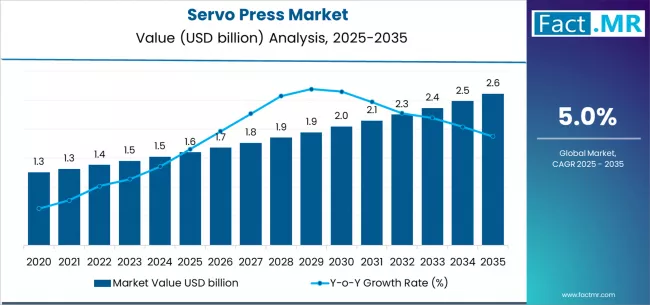
Between 2025 and 2030, the servo press market is projected to expand from USD 2.6 billion to USD 3.3 billion, resulting in a value increase of USD 0.7 billion, which represents 43.8% of the total forecast growth for the decade. This phase of development will be shaped by rising demand for precision manufacturing solutions and automotive production practices, product innovation in servo motor technologies and control systems, as well as expanding integration with Industry 4.0 platforms and smart manufacturing systems. Companies are establishing competitive positions through investment in servo technology research and development, high-efficiency drive systems, and strategic market expansion across automotive, electronics, and specialty applications.
From 2030 to 2035, the market is forecast to grow from USD 3.3 billion to USD 4.2 billion, adding another USD 0.9 billion, which constitutes 56.2% of the overall ten-year expansion. This period is expected to be characterized by the expansion of specialized servo press configurations, including advanced control systems and integrated manufacturing solutions tailored for specific industrial applications, strategic collaborations between servo press manufacturers and automotive companies, and an enhanced focus on energy efficiency and smart manufacturing practices. The growing emphasis on precision forming and production optimization will drive demand for comprehensive servo press solutions across diverse manufacturing applications.
Servo Press Market Key Takeaways
| Metric | Value |
|---|---|
| Market Value (2025) | USD 2.6 billion |
| Market Forecast Value (2035) | USD 4.2 billion |
| Forecast CAGR (2025-2035) | 5% |
Why is the Servo Press Market Growing?
The servo press market grows by enabling manufacturers to optimize metal forming processes while accessing precision manufacturing technologies without substantial energy consumption requirements. Manufacturing producers and industrial operations face mounting pressure to enhance production efficiency and comply with strict quality regulations, with servo press systems typically providing 85-95% energy efficiency rates compared to conventional alternatives, making advanced manufacturing solutions essential for competitive industrial positioning. The manufacturing industry's need for precision control and application-specific metal forming creates demand for comprehensive servo press solutions that can provide superior forming capabilities, maintain consistent performance, and ensure quality compliance without compromising production speed or operational standards.
Government initiatives promoting industrial modernization and smart manufacturing drive adoption in automotive, electronics, and aerospace applications, where servo press technology has a direct impact on product quality and manufacturing efficiency. However, system complexity constraints during installation phases and the expertise requirements for servo press deployment may limit accessibility among smaller manufacturers and developing regions with limited technical infrastructure for advanced manufacturing systems.
Segmental Analysis
The market is segmented by press type, application, capacity, and region. By press type, the market is divided into crank servo press, screw servo press, and others. Based on application, the market is categorized into automotive, electronics, and aerospace & others. By capacity, the market includes up to 200T, 200T-500T, and above 500T. Regionally, the market is divided into Asia Pacific, Europe, North America, and other key regions.
By Press Type, the Crank Servo Press Segment Accounts for a Dominant Market Share
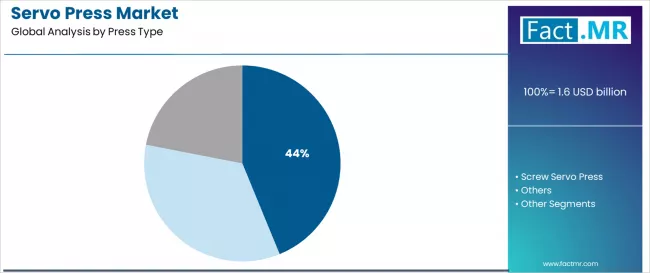
The crank servo press segment represents the dominant force in the servo press market, capturing approximately 43.8% of total market share in 2025. This established product category encompasses solutions featuring sophisticated servo motor technologies and mechanical systems, including advanced drive mechanisms and control systems that enable superior precision forming and metal working across all manufacturing conditions. The crank servo press segment's market leadership stems from its superior cost-effectiveness capabilities, with products capable of handling diverse forming challenges while maintaining consistent precision standards and operational reliability across all manufacturing environments.
The screw servo press segment maintains a substantial 31.7% market share, serving manufacturers who require advanced forming capabilities with enhanced pressure control features for complex metal forming and stamping operations. These products offer premium manufacturing solutions for high-precision applications while providing sufficient capability to meet regional quality control and industrial demands. The others segment accounts for approximately 24.5% of the market, serving specialized forming applications.
Key technological advantages driving the crank servo press segment include:
- Advanced servo motor technologies with integrated control mechanisms that reduce energy consumption and ensure consistent forming performance
- Multi-application compatibility options allowing simultaneous metal forming across different material types without performance degradation
- Enhanced precision features, delivering exact force control and positioning accuracy for complex forming operations
- Improved energy efficiency profiles enabling reduced operational costs and environmental compliance requirements
By Application, the Automotive Segment Accounts for the Largest Market Share
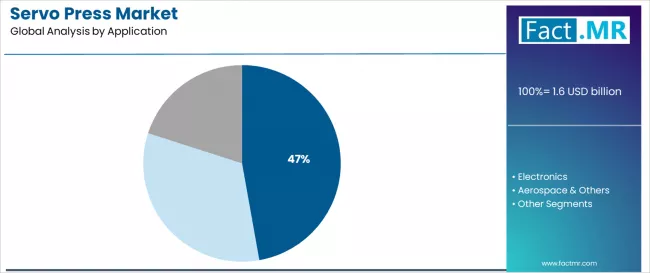
Automotive applications dominate the market with approximately 47.2% market share in 2025, reflecting the critical role of servo press technology in supporting global automotive manufacturing and metal forming operations worldwide. The automotive segment's market leadership is reinforced by increasing production requirements in vehicle manufacturing, technological advances in automotive components, and rising requirements for precision forming in integrated manufacturing programs across developed and emerging markets.
The electronics segment represents the second-largest application category, capturing 29.6% market share through specialized precision forming for electronic components, circuit board manufacturing, and electronic device applications. This segment benefits from growing demand for miniaturized components that meet specific precision requirements, quality standards, and performance protocols in competitive electronics markets.
The aerospace & others segment accounts for 23.2% market share, serving specialized applications including aircraft components, precision parts manufacturing, and high-performance forming applications across various industrial sectors.
Key market dynamics supporting application growth include:
- Automotive production expansion driven by electric vehicle manufacturing and component precision, requiring specialized forming facilities in emerging markets
- Electronics miniaturization trends require high-precision, standardized forming processes for component consistency and quality compliance
- Integration of aerospace technologies enabling precision component manufacturing and testing systems
- Growing emphasis on manufacturing precision driving demand for comprehensive, multi-application forming solutions
What are the Drivers, Restraints, and Key Trends of the Servo Press Market?
The market is driven by three concrete demand factors tied to manufacturing efficiency outcomes. First, automotive production growth and industrial modernization initiatives create increasing demand for precision forming systems, with automotive manufacturing expanding by 10-15% annually in major developing countries worldwide, requiring comprehensive servo press infrastructure. Second, government initiatives promoting industrial automation and smart manufacturing drive increased adoption of servo technologies, with many countries implementing Industry 4.0 goals for manufacturing modernization by 2030. Third, technological advancements in servo motor technology and control systems enable more efficient and cost-competitive manufacturing solutions that reduce energy consumption while improving forming precision and production capabilities.
Market restraints include high initial investment costs for servo press systems that can deter new market entrants from developing comprehensive manufacturing capabilities, particularly in developing regions where funding for advanced equipment remains limited. Technical complexity and integration requirements pose another significant challenge, as servo press systems demand extensive setup procedures and operator training, potentially causing increased implementation costs and deployment delays. Operator education and technical support requirements across different regions create additional operational challenges for equipment adoption, demanding ongoing investment in training services and maintenance programs.
Key trends indicate accelerated adoption in Asia-Pacific markets, particularly India and China, where manufacturing expansion and export quality requirements drive comprehensive servo press adoption. Technology integration trends toward smart manufacturing systems with predictive maintenance, real-time monitoring, and integrated control solutions enable proactive production approaches that optimize efficiency and minimize downtime. However, the market thesis could face disruption if significant advances in alternative forming technologies or major changes in manufacturing approaches reduce reliance on traditional servo press technologies.
Analysis of the Servo Press Market by Key Country
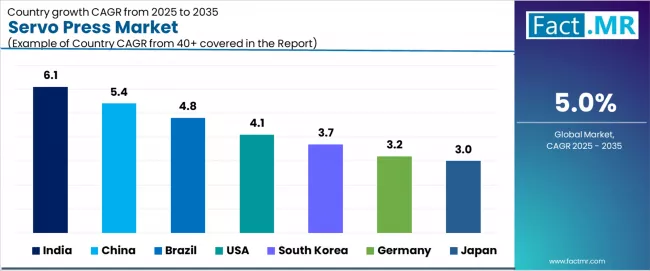
| Country | CAGR (2025-2035) |
|---|---|
| India | 6.1% |
| China | 5.4% |
| Brazil | 4.8% |
| USA | 4.1% |
| South Korea | 3.7% |
| Germany | 3.2% |
| Japan | 3% |
The servo press market is gaining momentum worldwide, with India taking the lead thanks to policy support for manufacturing modernization and expanding automotive production initiatives. Close behind, China benefits from industrial automation targets and massive manufacturing production scale, positioning itself as a strategic growth hub in the Asia-Pacific region. Brazil shows strong advancement, where manufacturing automation adoption in automotive and industrial sectors strengthens its role in the South American manufacturing supply chain. The USA stands out for its servo press integration in automotive production and technology incentive programs, while South Korea demonstrates consistent progress in electronics manufacturing and industrial automation compliance. Germany and Japan continue to record solid progress in precision manufacturing and industrial modernization respectively. Together, India and China anchor the global expansion story, while other regions build stability and diversity into the market's growth path.
India Leads Global Market Expansion
India demonstrates the strongest growth potential in the Servo Press Market with a CAGR of 6.1% through 2035. The country's leadership position stems from policy push for manufacturing modernization, government-backed industrial development programs, and stringent quality regulations driving the adoption of advanced servo press solutions. Growth is concentrated in major manufacturing centers, including Maharashtra, Gujarat, Tamil Nadu, and Karnataka, where automotive facilities and industrial production centers are implementing advanced servo press solutions for enhanced manufacturing capabilities and export compliance. Distribution channels through industrial distributors and equipment suppliers expand deployment across automotive manufacturing projects and precision forming initiatives. The country's Make in India program provides policy support for manufacturing modernization, including advanced servo press adoption.
Key market factors:
- Manufacturing expansion concentrated in automotive belts and industrial zones with comprehensive manufacturing development programs
- Government support through industrial development programs and export promotion initiatives
- Comprehensive servo press technology ecosystem, including established equipment providers with proven track records
- Technology integration featuring advanced servo motor platforms, control systems, and precision optimization technologies
China Emerges as High-Growth Market
In Beijing, Shanghai, Guangzhou, and Shenzhen, the adoption of comprehensive servo press solutions is accelerating across automotive production and electronics manufacturing initiatives, driven by industrial automation targets and government modernization programs. The market demonstrates strong growth momentum with a CAGR of 5.4% through 2035, linked to comprehensive manufacturing modernization and increasing focus on production quality automation solutions. Chinese manufacturers are implementing advanced servo press systems and precision forming platforms to enhance production quality while meeting growing demand in expanding export manufacturing and domestic industrial sectors. The country's Made in China 2025 initiatives create continued demand for servo press solutions, while increasing emphasis on smart manufacturing drives adoption of advanced servo control systems.
Key development areas:
- Manufacturing facilities and automotive production centers leading servo press technology adoption with comprehensive modernization programs
- Supply chain channels providing integrated solutions with 90% efficiency improvement rates
- Technology partnerships between servo press companies and manufacturing enterprises are expanding market reach
- Integration of smart manufacturing technologies and comprehensive production management systems
Brazil Shows Strong Regional Leadership
Brazil's market expansion is driven by diverse manufacturing demand, including automotive production in São Paulo and industrial manufacturing in Rio Grande do Sul, and comprehensive automation adoption across multiple states. The country demonstrates promising growth potential with a CAGR of 4.8% through 2035, supported by federal government industrial investment programs and state-level manufacturing development initiatives. Brazilian manufacturers face implementation challenges related to technology financing constraints and technical expertise availability, requiring phased deployment approaches and support from international suppliers. However, growing export demands and quality requirements create compelling business cases for servo press adoption, particularly in manufacturing areas where precision forming has a direct impact on market competitiveness.
Market characteristics:
- Automotive and industrial segments showing fastest growth with 25% annual increase in servo press utilization
- Regional expansion trends focused on manufacturing areas in southeastern and southern states
- Future projections indicate the need for local technical support infrastructure and operator training programs
- Growing emphasis on export quality and international competitiveness in manufacturing operations
United States Demonstrates Technology Innovation
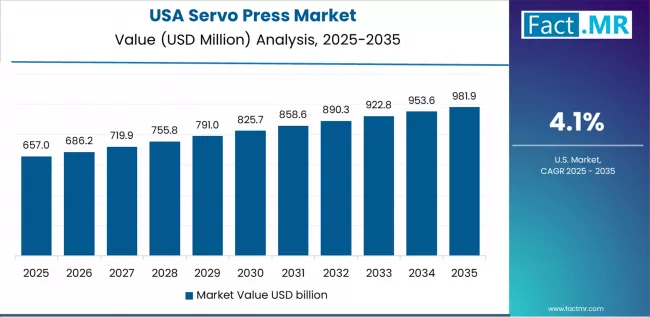
The U.S. market leads in advanced servo press innovation based on integration with smart manufacturing systems and industrial automation technologies for enhanced operational performance. The country shows strong potential with a CAGR of 4.1% through 2035, driven by the modernization of existing manufacturing infrastructure and the expansion of automotive production facilities in major industrial areas, including Michigan, Ohio, Indiana, and Texas. American manufacturers are adopting intelligent servo press systems for quality improvement and efficiency enhancement, particularly in regions with advanced manufacturing requirements and export applications demanding comprehensive forming upgrades. Technology deployment channels through established industrial distributors and manufacturing service companies expand coverage across production facilities and automation-focused operators.
Leading market segments:
- Automotive manufacturing modernization projects in major industrial centers are implementing comprehensive servo press upgrades
- Manufacturing partnerships with technology providers, achieving 85% forming precision improvement rates
- Strategic collaborations between servo press companies and manufacturing operations are expanding market presence
- Focus on high-performance systems and specialized forming requirements
South Korea Emphasizes Manufacturing Precision
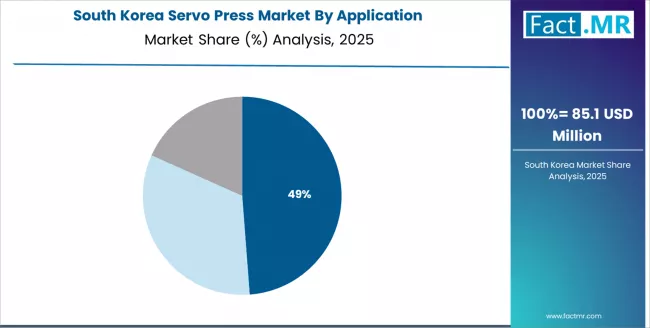
In Seoul, Busan, Incheon, and Ulsan, manufacturing facilities are implementing comprehensive servo press solutions to modernize existing forming infrastructure and improve production accuracy, with documented case studies showing a 30% improvement in forming precision through advanced servo press systems. The market shows strong growth potential with a CAGR of 3.7% through 2035, linked to the ongoing modernization of manufacturing facilities, electronics production networks, and emerging smart manufacturing projects in major regions. Korean manufacturers are adopting intelligent servo press and monitoring platforms to enhance production reliability while maintaining quality standards demanded by the electronics industry and export markets. The country's established manufacturing infrastructure creates continued demand for system upgrade and modernization solutions that integrate with existing production systems.
Germany Shows Industrial Excellence
Germany's servo press market demonstrates sophisticated implementation focused on precision manufacturing and industrial automation optimization, with documented integration of advanced servo press systems, achieving 35% improvement in energy efficiency across manufacturing and industrial facilities. The country maintains steady growth momentum with a CAGR of 3.2% through 2035, driven by manufacturing facilities' emphasis on Industry 4.0 standards and continuous improvement methodologies that align with international quality requirements applied to production operations. Major industrial areas, including Baden-Württemberg, Bavaria, North Rhine-Westphalia, and Lower Saxony, showcase advanced deployment of servo press platforms where forming systems integrate seamlessly with existing manufacturing control systems and comprehensive quality management programs.
Key market characteristics:
- Manufacturing facilities and automotive production centers are driving advanced servo press requirements with emphasis on precision and efficiency
- Quality management partnerships enabling 95% precision compliance with comprehensive monitoring programs
- Technology collaboration between German companies and international servo press providers is expanding market capabilities
- Emphasis on industrial excellence and continuous improvement methodologies
Japan Emphasizes Precision Integration
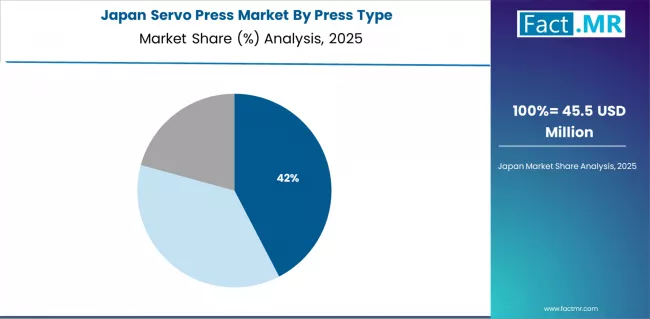
Japan's Servo Press Market demonstrates mature and precision-focused landscape, characterized by sophisticated integration of servo press systems with existing manufacturing infrastructure across automotive facilities, electronics production networks, and industrial automation initiatives. Japan's emphasis on manufacturing precision and quality standards drives demand for high-reliability servo press solutions that support comprehensive manufacturing initiatives and efficiency requirements in industrial operations. The market benefits from strong partnerships between international servo press providers and domestic manufacturing leaders, creating comprehensive service ecosystems that prioritize system precision and operator training programs. Manufacturing centers in major industrial regions showcase advanced servo press implementations where forming systems achieve 92% efficiency through integrated monitoring programs.
Europe Market Split by Country
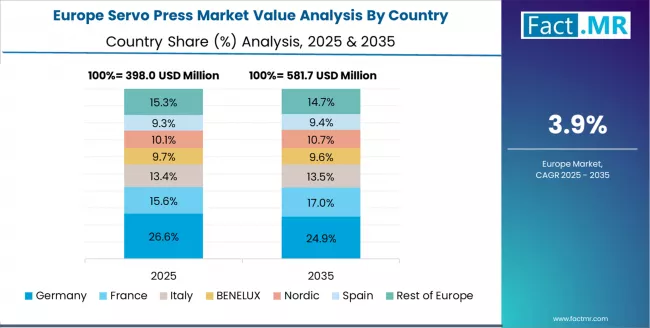
The servo press market in Europe is projected to grow from USD 0.7 billion in 2025 to USD 1 billion by 2035, registering a CAGR of 4.2% over the forecast period. Germany is expected to maintain its leadership position with a 25.3% market share in 2025, supported by its extensive automotive manufacturing infrastructure, advanced industrial automation facilities, and comprehensive precision manufacturing networks serving major European markets.
The UK follows with a 15% share in 2025, driven by comprehensive manufacturing modernization in major industrial regions implementing advanced servo press systems. France holds a 14.9% share through the ongoing development of automotive production facilities and industrial automation networks. Italy commands a 12.7% share, while Spain accounts for 9.6% in 2025. The Rest of Europe region is anticipated to maintain its collective share at 22.5%, attributed to steady servo press adoption across Nordic countries and emerging Eastern European manufacturing facilities implementing industrial automation programs.
Competitive Landscape of the Servo Press Market
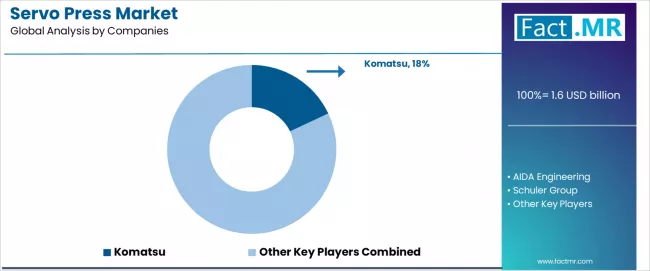
The servo press market features approximately 40-50 meaningful players with moderate concentration, where the top three companies control roughly 25-32% of global market share through established servo press product portfolios and extensive manufacturing industry relationships. Competition centers on technology innovation, precision capabilities, and system integration rather than price competition alone.
Market leaders include Komatsu, AIDA Engineering, and Schuler Group, which maintain competitive advantages through comprehensive servo press solution portfolios, global distribution networks, and deep expertise in the precision manufacturing and metal forming sectors, creating high switching costs for customers. These companies leverage established manufacturer relationships and ongoing technical support services to defend market positions while expanding into adjacent automation and smart manufacturing applications.
Challengers encompass Nidec-Shimpo and Fagor Arrasate, which compete through specialized servo press configurations and strong regional presence in key manufacturing markets. Technology specialists, including Beckwood Press, Chin Fong Machine, and Sutherland Presses, focus on specific servo technologies or specialized applications, offering differentiated capabilities in custom forming solutions, advanced control systems, and application-specific equipment.
Regional players and emerging servo press companies create competitive pressure through innovative technologies and rapid market deployment capabilities, particularly in high-growth markets including India and China, where local presence provides advantages in customer support and technical service. Market dynamics favor companies that combine advanced servo press technologies with comprehensive support services that address the complete manufacturing lifecycle from equipment installation through ongoing maintenance and performance optimization.
Regional players and emerging servo press companies create competitive pressure through innovative technologies and rapid market deployment capabilities, particularly in high-growth markets including India and China, where local presence provides advantages in customer support and technical service. Market dynamics favor companies that combine advanced servo press technologies with comprehensive support services that address the complete manufacturing lifecycle from equipment installation through ongoing maintenance and performance optimization.
Global Servo Press Market - Stakeholder Contribution Framework
Servo press solutions represent a critical manufacturing technology that enables manufacturers, industrial producers, and production departments to enhance forming precision and energy efficiency without substantial operational complexity requirements, typically providing 85-95% energy efficiency rates comparable to conventional alternatives while reducing operational costs. With the market projected to grow from USD 2.6 billion in 2025 to USD 4.2 billion by 2035 at a 5% CAGR, these solutions offer compelling advantages - superior precision, enhanced energy efficiency, and advanced control capabilities - making them essential for automotive manufacturing (growing segment), electronics production operations (expanding adoption), and diverse industrial applications seeking reliable precision forming solutions. Scaling market penetration and servo press capabilities requires coordinated action across industrial policy, manufacturing standards, servo press manufacturers, technology providers, and research institutions.
How Governments Could Spur Local Production and Adoption?
- Industrial Modernization Programs: Include servo press capabilities in national manufacturing development initiatives, providing targeted funding for industrial automation facilities in underserved regions and supporting local technology companies through innovation grants and development support.
- Tax Policy & R&D Support: Implement accelerated depreciation schedules for servo press equipment, provide tax incentives for companies investing in advanced servo motor and control technologies, and establish favorable research accounting standards that encourage servo press adoption over conventional forming approaches.
- Regulatory Framework Development: Create streamlined equipment certification processes across automotive and electronics manufacturing applications, establish clear performance testing frameworks for servo press operation, and develop international standards that facilitate cross-border servo press equipment trade.
- Skills Development & Training: Fund vocational programs for servo press technicians, manufacturing automation specialists, and precision forming professionals. Invest in technology transfer initiatives that bridge academic research with commercial servo press development and application optimization systems.
- Market Access & Competition: Establish procurement policies that favor advanced manufacturing solutions for government facility applications, support small and medium manufacturing operations through preferential lending programs, and create regulatory environments that encourage innovation in servo press technologies.
How Industry Bodies Could Support Market Development?
- Performance Standards & Certification: Define standardized performance metrics for servo press systems across automotive, electronics, and industrial manufacturing applications, establish universal precision and efficiency protocols, and create certification programs for equipment performance that manufacturers can rely on.
- Market Education & Best Practices: Lead messaging that demonstrates servo press advantages, emphasizing improved precision, enhanced energy efficiency, and superior control compatibility compared to conventional alternatives.
- Technology Integration Standards: Develop interoperability standards for servo press systems, manufacturing automation compatibility guidelines, and smart manufacturing platforms, ensuring seamless integration across different industrial environments and production requirements.
- Professional Development: Run certification programs for operators, servo press specialists, and technical service teams on optimizing servo press performance, maintenance procedures, and precision manufacturing in competitive industrial markets.
How Manufacturers and Technology Players Could Strengthen the Ecosystem?
- Advanced Servo Press Development: Develop next-generation servo press systems with enhanced motor capabilities, improved control precision, and application-specific forming features that enhance manufacturing reliability while reducing energy consumption.
- Intelligence Platforms: Provide comprehensive servo press software that integrates production monitoring, predictive maintenance, process optimization, and quality control systems, enabling manufacturers to maximize system efficiency and operational performance.
- Service & Support Networks: Offer flexible support programs for manufacturing operations and industrial departments, including technical training options, maintenance consultation services, and performance optimization pathways that keep servo press systems current with production demands.
- Research & Development Networks: Build comprehensive R&D capabilities, collaborative servo press innovation programs, and application development systems that ensure servo press technologies maintain high precision rates and consistent performance across diverse manufacturing environments.
How Suppliers Could Navigate the Shift?
- Diversified Product Portfolios: Expand servo press offerings across automotive manufacturing (growing adoption), electronics production (expanding segment), and industrial applications, with particular focus on crank servo press products (43.8% market dominance) and specialized solutions for capacity-specific requirements.
- Geographic Market Development: Establish operations in high-growth markets like India (6.1% CAGR) and China (5.4% CAGR), while strengthening presence in established markets like Brazil (4.8% CAGR) and USA (4.1% CAGR) through regional servo press capabilities and local partnerships.
- Technology-Enabled Services: Implement advanced monitoring systems with real-time performance tracking, automated maintenance recommendations, and predictive service capabilities that differentiate service offerings and improve customer satisfaction and retention.
- Flexible Service Models: Develop standard, premium, and custom servo press solutions that accommodate varying manufacturer needs, from cost-effective forming applications to high-performance requirements for demanding automotive and electronics applications.
How Investors and Financial Enablers Could Unlock Value?
- Servo Press Technology Expansion Financing: Provide growth capital for established companies like Komatsu, AIDA Engineering, and Schuler Group to expand servo press production capacity and geographic coverage, particularly in emerging markets with growing manufacturing demands.
- Innovation Investment: Back startups developing advanced servo motor technologies, control system platforms, and intelligent forming systems that enhance manufacturing industry efficiency and competitive positioning.
- Regional Market Development: Finance market entry and expansion strategies for servo press companies establishing operations in high-growth regions, supporting localization initiatives that reduce equipment costs while maintaining precision standards.
- Consolidation & Scale Opportunities: Support strategic acquisitions and market consolidation that create economies of scale, improve servo press capabilities, and enhance competitive positioning against fragmented regional providers across multiple geographic markets.
Key Players in the Servo Press Market
- Komatsu
- AIDA Engineering
- Schuler Group
- Nidec-Shimpo
- Fagor Arrasate
- Beckwood Press
- Chin Fong Machine
- Sutherland Presses
- Isgec Heavy Engineering
- Amada Holdings
- SIMPAC
- Yangli Group
- Hoden Seimitsu
- SEYI
- JIER Machine Tool
Scope of the Report
| Items | Values |
|---|---|
| Quantitative Units | USD 2.6 billion |
| Press Type | Crank Servo Press, Screw Servo Press, Others |
| Application | Automotive, Electronics, Aerospace & Others |
| Capacity | Up to 200T, 200T-500T, Above 500T |
| Regions Covered | Asia Pacific, Europe, North America, Latin America, Middle East & Africa |
| Country Covered | India, China, Brazil, USA, South Korea, Germany, Japan, and 40+ countries |
| Key Companies Profiled | Komatsu, AIDA Engineering, Schuler Group, Nidec-Shimpo, Fagor Arrasate, Beckwood Press, Chin Fong Machine, Sutherland Presses, Isgec Heavy Engineering, Amada Holdings |
| Additional Attributes | Dollar sales by press type and application categories, regional adoption trends across Asia Pacific, Europe, and North America, competitive landscape with servo press solution providers and manufacturing companies, industrial facility requirements and specifications, integration with smart manufacturing initiatives and automation platforms, innovations in servo motor technology and control systems, and development of specialized applications with precision forming capabilities and energy efficiency features. |
Servo Press Market by Segments
-
Press Type :
- Crank Servo Press
- Screw Servo Press
- Others
-
Application :
- Automotive
- Electronics
- Aerospace & Others
-
Capacity :
- Up to 200T
- 200T-500T
- Above 500T
-
Region :
- Asia Pacific
- China
- Japan
- South Korea
- India
- Australia & New Zealand
- ASEAN
- Rest of Asia Pacific
- Europe
- Germany
- United Kingdom
- France
- Italy
- Spain
- Nordic
- BENELUX
- Rest of Europe
- North America
- United States
- Canada
- Mexico
- Latin America
- Brazil
- Chile
- Rest of Latin America
- Middle East & Africa
- Kingdom of Saudi Arabia
- Other GCC Countries
- Turkey
- South Africa
- Other African Union
- Rest of Middle East & Africa
- Asia Pacific
Table of Content
- Executive Summary
- Global Market Outlook
- Demand to side Trends
- Supply to side Trends
- Technology Roadmap Analysis
- Analysis and Recommendations
- Market Overview
- Market Coverage / Taxonomy
- Market Definition / Scope / Limitations
- Market Background
- Market Dynamics
- Drivers
- Restraints
- Opportunity
- Trends
- Scenario Forecast
- Demand in Optimistic Scenario
- Demand in Likely Scenario
- Demand in Conservative Scenario
- Opportunity Map Analysis
- Product Life Cycle Analysis
- Supply Chain Analysis
- Investment Feasibility Matrix
- Value Chain Analysis
- PESTLE and Porter’s Analysis
- Regulatory Landscape
- Regional Parent Market Outlook
- Production and Consumption Statistics
- Import and Export Statistics
- Market Dynamics
- Global Market Analysis 2020 to 2024 and Forecast, 2025 to 2035
- Historical Market Size Value (USD Million) Analysis, 2020 to 2024
- Current and Future Market Size Value (USD Million) Projections, 2025 to 2035
- Y to o to Y Growth Trend Analysis
- Absolute $ Opportunity Analysis
- Global Market Pricing Analysis 2020 to 2024 and Forecast 2025 to 2035
- Global Market Analysis 2020 to 2024 and Forecast 2025 to 2035, By Press Type
- Introduction / Key Findings
- Historical Market Size Value (USD Million) Analysis By Press Type , 2020 to 2024
- Current and Future Market Size Value (USD Million) Analysis and Forecast By Press Type , 2025 to 2035
- Crank Servo Press
- Screw Servo Press
- Others
- Y to o to Y Growth Trend Analysis By Press Type , 2020 to 2024
- Absolute $ Opportunity Analysis By Press Type , 2025 to 2035
- Global Market Analysis 2020 to 2024 and Forecast 2025 to 2035, By Application
- Introduction / Key Findings
- Historical Market Size Value (USD Million) Analysis By Application, 2020 to 2024
- Current and Future Market Size Value (USD Million) Analysis and Forecast By Application, 2025 to 2035
- Automotive
- Electronics
- Aerospace & Others
- Y to o to Y Growth Trend Analysis By Application, 2020 to 2024
- Absolute $ Opportunity Analysis By Application, 2025 to 2035
- Global Market Analysis 2020 to 2024 and Forecast 2025 to 2035, By Region
- Introduction
- Historical Market Size Value (USD Million) Analysis By Region, 2020 to 2024
- Current Market Size Value (USD Million) Analysis and Forecast By Region, 2025 to 2035
- North America
- Latin America
- Western Europe
- Eastern Europe
- East Asia
- South Asia and Pacific
- Middle East & Africa
- Market Attractiveness Analysis By Region
- North America Market Analysis 2020 to 2024 and Forecast 2025 to 2035, By Country
- Historical Market Size Value (USD Million) Trend Analysis By Market Taxonomy, 2020 to 2024
- Market Size Value (USD Million) Forecast By Market Taxonomy, 2025 to 2035
- By Country
- USA
- Canada
- Mexico
- By Press Type
- By Application
- By Country
- Market Attractiveness Analysis
- By Country
- By Press Type
- By Application
- Key Takeaways
- Latin America Market Analysis 2020 to 2024 and Forecast 2025 to 2035, By Country
- Historical Market Size Value (USD Million) Trend Analysis By Market Taxonomy, 2020 to 2024
- Market Size Value (USD Million) Forecast By Market Taxonomy, 2025 to 2035
- By Country
- Brazil
- Chile
- Rest of Latin America
- By Press Type
- By Application
- By Country
- Market Attractiveness Analysis
- By Country
- By Press Type
- By Application
- Key Takeaways
- Western Europe Market Analysis 2020 to 2024 and Forecast 2025 to 2035, By Country
- Historical Market Size Value (USD Million) Trend Analysis By Market Taxonomy, 2020 to 2024
- Market Size Value (USD Million) Forecast By Market Taxonomy, 2025 to 2035
- By Country
- Germany
- UK
- Italy
- Spain
- France
- Nordic
- BENELUX
- Rest of Western Europe
- By Press Type
- By Application
- By Country
- Market Attractiveness Analysis
- By Country
- By Press Type
- By Application
- Key Takeaways
- Eastern Europe Market Analysis 2020 to 2024 and Forecast 2025 to 2035, By Country
- Historical Market Size Value (USD Million) Trend Analysis By Market Taxonomy, 2020 to 2024
- Market Size Value (USD Million) Forecast By Market Taxonomy, 2025 to 2035
- By Country
- Russia
- Poland
- Hungary
- Balkan & Baltic
- Rest of Eastern Europe
- By Press Type
- By Application
- By Country
- Market Attractiveness Analysis
- By Country
- By Press Type
- By Application
- Key Takeaways
- East Asia Market Analysis 2020 to 2024 and Forecast 2025 to 2035, By Country
- Historical Market Size Value (USD Million) Trend Analysis By Market Taxonomy, 2020 to 2024
- Market Size Value (USD Million) Forecast By Market Taxonomy, 2025 to 2035
- By Country
- China
- Japan
- South Korea
- By Press Type
- By Application
- By Country
- Market Attractiveness Analysis
- By Country
- By Press Type
- By Application
- Key Takeaways
- South Asia and Pacific Market Analysis 2020 to 2024 and Forecast 2025 to 2035, By Country
- Historical Market Size Value (USD Million) Trend Analysis By Market Taxonomy, 2020 to 2024
- Market Size Value (USD Million) Forecast By Market Taxonomy, 2025 to 2035
- By Country
- India
- ASEAN
- Australia & New Zealand
- Rest of South Asia and Pacific
- By Press Type
- By Application
- By Country
- Market Attractiveness Analysis
- By Country
- By Press Type
- By Application
- Key Takeaways
- Middle East & Africa Market Analysis 2020 to 2024 and Forecast 2025 to 2035, By Country
- Historical Market Size Value (USD Million) Trend Analysis By Market Taxonomy, 2020 to 2024
- Market Size Value (USD Million) Forecast By Market Taxonomy, 2025 to 2035
- By Country
- Kingdom of Saudi Arabia
- Other GCC Countries
- Turkiye
- South Africa
- Other African Union
- Rest of Middle East & Africa
- By Press Type
- By Application
- By Country
- Market Attractiveness Analysis
- By Country
- By Press Type
- By Application
- Key Takeaways
- Key Countries Market Analysis
- USA
- Pricing Analysis
- Market Share Analysis, 2024
- By Press Type
- By Application
- Canada
- Pricing Analysis
- Market Share Analysis, 2024
- By Press Type
- By Application
- Mexico
- Pricing Analysis
- Market Share Analysis, 2024
- By Press Type
- By Application
- Brazil
- Pricing Analysis
- Market Share Analysis, 2024
- By Press Type
- By Application
- Chile
- Pricing Analysis
- Market Share Analysis, 2024
- By Press Type
- By Application
- Germany
- Pricing Analysis
- Market Share Analysis, 2024
- By Press Type
- By Application
- UK
- Pricing Analysis
- Market Share Analysis, 2024
- By Press Type
- By Application
- Italy
- Pricing Analysis
- Market Share Analysis, 2024
- By Press Type
- By Application
- Spain
- Pricing Analysis
- Market Share Analysis, 2024
- By Press Type
- By Application
- France
- Pricing Analysis
- Market Share Analysis, 2024
- By Press Type
- By Application
- India
- Pricing Analysis
- Market Share Analysis, 2024
- By Press Type
- By Application
- ASEAN
- Pricing Analysis
- Market Share Analysis, 2024
- By Press Type
- By Application
- Australia & New Zealand
- Pricing Analysis
- Market Share Analysis, 2024
- By Press Type
- By Application
- China
- Pricing Analysis
- Market Share Analysis, 2024
- By Press Type
- By Application
- Japan
- Pricing Analysis
- Market Share Analysis, 2024
- By Press Type
- By Application
- South Korea
- Pricing Analysis
- Market Share Analysis, 2024
- By Press Type
- By Application
- Russia
- Pricing Analysis
- Market Share Analysis, 2024
- By Press Type
- By Application
- Poland
- Pricing Analysis
- Market Share Analysis, 2024
- By Press Type
- By Application
- Hungary
- Pricing Analysis
- Market Share Analysis, 2024
- By Press Type
- By Application
- Kingdom of Saudi Arabia
- Pricing Analysis
- Market Share Analysis, 2024
- By Press Type
- By Application
- Turkiye
- Pricing Analysis
- Market Share Analysis, 2024
- By Press Type
- By Application
- South Africa
- Pricing Analysis
- Market Share Analysis, 2024
- By Press Type
- By Application
- USA
- Market Structure Analysis
- Competition Dashboard
- Competition Benchmarking
- Market Share Analysis of Top Players
- By Regional
- By Press Type
- By Application
- Competition Analysis
- Competition Deep Dive
- Komatsu
- Overview
- Product Portfolio
- Profitability by Market Segments (Product/Age /Sales Channel/Region)
- Sales Footprint
- Strategy Overview
- Marketing Strategy
- Product Strategy
- Channel Strategy
- AIDA Engineering
- Schuler Group
- Nidec-Shimpo
- Fagor Arrasate
- Beckwood Press
- Chin Fong Machine
- Sutherland Presses
- Isgec Heavy Engineering
- Amada Holdings
- SIMPAC
- Yangli Group
- Hoden Seimitsu
- SEYI
- JIER Machine Tool
- Komatsu
- Competition Deep Dive
- Assumptions & Acronyms Used
- Research Methodology
List Of Table
- Table 1: Global Market Value (USD Million) Forecast by Region, 2020 to 2035
- Table 2: Global Market Value (USD Million) Forecast by Press Type , 2020 to 2035
- Table 3: Global Market Value (USD Million) Forecast by Application, 2020 to 2035
- Table 4: North America Market Value (USD Million) Forecast by Country, 2020 to 2035
- Table 5: North America Market Value (USD Million) Forecast by Press Type , 2020 to 2035
- Table 6: North America Market Value (USD Million) Forecast by Application, 2020 to 2035
- Table 7: Latin America Market Value (USD Million) Forecast by Country, 2020 to 2035
- Table 8: Latin America Market Value (USD Million) Forecast by Press Type , 2020 to 2035
- Table 9: Latin America Market Value (USD Million) Forecast by Application, 2020 to 2035
- Table 10: Western Europe Market Value (USD Million) Forecast by Country, 2020 to 2035
- Table 11: Western Europe Market Value (USD Million) Forecast by Press Type , 2020 to 2035
- Table 12: Western Europe Market Value (USD Million) Forecast by Application, 2020 to 2035
- Table 13: Eastern Europe Market Value (USD Million) Forecast by Country, 2020 to 2035
- Table 14: Eastern Europe Market Value (USD Million) Forecast by Press Type , 2020 to 2035
- Table 15: Eastern Europe Market Value (USD Million) Forecast by Application, 2020 to 2035
- Table 16: East Asia Market Value (USD Million) Forecast by Country, 2020 to 2035
- Table 17: East Asia Market Value (USD Million) Forecast by Press Type , 2020 to 2035
- Table 18: East Asia Market Value (USD Million) Forecast by Application, 2020 to 2035
- Table 19: South Asia and Pacific Market Value (USD Million) Forecast by Country, 2020 to 2035
- Table 20: South Asia and Pacific Market Value (USD Million) Forecast by Press Type , 2020 to 2035
- Table 21: South Asia and Pacific Market Value (USD Million) Forecast by Application, 2020 to 2035
- Table 22: Middle East & Africa Market Value (USD Million) Forecast by Country, 2020 to 2035
- Table 23: Middle East & Africa Market Value (USD Million) Forecast by Press Type , 2020 to 2035
- Table 24: Middle East & Africa Market Value (USD Million) Forecast by Application, 2020 to 2035
List Of Figures
- Figure 1: Global Market Pricing Analysis
- Figure 2: Global Market Value (USD Million) Forecast 2020-2035
- Figure 3: Global Market Value Share and BPS Analysis by Press Type , 2025 and 2035
- Figure 4: Global Market Y to o to Y Growth Comparison by Press Type , 2025-2035
- Figure 5: Global Market Attractiveness Analysis by Press Type
- Figure 6: Global Market Value Share and BPS Analysis by Application, 2025 and 2035
- Figure 7: Global Market Y to o to Y Growth Comparison by Application, 2025-2035
- Figure 8: Global Market Attractiveness Analysis by Application
- Figure 9: Global Market Value (USD Million) Share and BPS Analysis by Region, 2025 and 2035
- Figure 10: Global Market Y to o to Y Growth Comparison by Region, 2025-2035
- Figure 11: Global Market Attractiveness Analysis by Region
- Figure 12: North America Market Incremental Dollar Opportunity, 2025-2035
- Figure 13: Latin America Market Incremental Dollar Opportunity, 2025-2035
- Figure 14: Western Europe Market Incremental Dollar Opportunity, 2025-2035
- Figure 15: Eastern Europe Market Incremental Dollar Opportunity, 2025-2035
- Figure 16: East Asia Market Incremental Dollar Opportunity, 2025-2035
- Figure 17: South Asia and Pacific Market Incremental Dollar Opportunity, 2025-2035
- Figure 18: Middle East & Africa Market Incremental Dollar Opportunity, 2025-2035
- Figure 19: North America Market Value Share and BPS Analysis by Country, 2025 and 2035
- Figure 20: North America Market Value Share and BPS Analysis by Press Type , 2025 and 2035
- Figure 21: North America Market Y to o to Y Growth Comparison by Press Type , 2025-2035
- Figure 22: North America Market Attractiveness Analysis by Press Type
- Figure 23: North America Market Value Share and BPS Analysis by Application, 2025 and 2035
- Figure 24: North America Market Y to o to Y Growth Comparison by Application, 2025-2035
- Figure 25: North America Market Attractiveness Analysis by Application
- Figure 26: Latin America Market Value Share and BPS Analysis by Country, 2025 and 2035
- Figure 27: Latin America Market Value Share and BPS Analysis by Press Type , 2025 and 2035
- Figure 28: Latin America Market Y to o to Y Growth Comparison by Press Type , 2025-2035
- Figure 29: Latin America Market Attractiveness Analysis by Press Type
- Figure 30: Latin America Market Value Share and BPS Analysis by Application, 2025 and 2035
- Figure 31: Latin America Market Y to o to Y Growth Comparison by Application, 2025-2035
- Figure 32: Latin America Market Attractiveness Analysis by Application
- Figure 33: Western Europe Market Value Share and BPS Analysis by Country, 2025 and 2035
- Figure 34: Western Europe Market Value Share and BPS Analysis by Press Type , 2025 and 2035
- Figure 35: Western Europe Market Y to o to Y Growth Comparison by Press Type , 2025-2035
- Figure 36: Western Europe Market Attractiveness Analysis by Press Type
- Figure 37: Western Europe Market Value Share and BPS Analysis by Application, 2025 and 2035
- Figure 38: Western Europe Market Y to o to Y Growth Comparison by Application, 2025-2035
- Figure 39: Western Europe Market Attractiveness Analysis by Application
- Figure 40: Eastern Europe Market Value Share and BPS Analysis by Country, 2025 and 2035
- Figure 41: Eastern Europe Market Value Share and BPS Analysis by Press Type , 2025 and 2035
- Figure 42: Eastern Europe Market Y to o to Y Growth Comparison by Press Type , 2025-2035
- Figure 43: Eastern Europe Market Attractiveness Analysis by Press Type
- Figure 44: Eastern Europe Market Value Share and BPS Analysis by Application, 2025 and 2035
- Figure 45: Eastern Europe Market Y to o to Y Growth Comparison by Application, 2025-2035
- Figure 46: Eastern Europe Market Attractiveness Analysis by Application
- Figure 47: East Asia Market Value Share and BPS Analysis by Country, 2025 and 2035
- Figure 48: East Asia Market Value Share and BPS Analysis by Press Type , 2025 and 2035
- Figure 49: East Asia Market Y to o to Y Growth Comparison by Press Type , 2025-2035
- Figure 50: East Asia Market Attractiveness Analysis by Press Type
- Figure 51: East Asia Market Value Share and BPS Analysis by Application, 2025 and 2035
- Figure 52: East Asia Market Y to o to Y Growth Comparison by Application, 2025-2035
- Figure 53: East Asia Market Attractiveness Analysis by Application
- Figure 54: South Asia and Pacific Market Value Share and BPS Analysis by Country, 2025 and 2035
- Figure 55: South Asia and Pacific Market Value Share and BPS Analysis by Press Type , 2025 and 2035
- Figure 56: South Asia and Pacific Market Y to o to Y Growth Comparison by Press Type , 2025-2035
- Figure 57: South Asia and Pacific Market Attractiveness Analysis by Press Type
- Figure 58: South Asia and Pacific Market Value Share and BPS Analysis by Application, 2025 and 2035
- Figure 59: South Asia and Pacific Market Y to o to Y Growth Comparison by Application, 2025-2035
- Figure 60: South Asia and Pacific Market Attractiveness Analysis by Application
- Figure 61: Middle East & Africa Market Value Share and BPS Analysis by Country, 2025 and 2035
- Figure 62: Middle East & Africa Market Value Share and BPS Analysis by Press Type , 2025 and 2035
- Figure 63: Middle East & Africa Market Y to o to Y Growth Comparison by Press Type , 2025-2035
- Figure 64: Middle East & Africa Market Attractiveness Analysis by Press Type
- Figure 65: Middle East & Africa Market Value Share and BPS Analysis by Application, 2025 and 2035
- Figure 66: Middle East & Africa Market Y to o to Y Growth Comparison by Application, 2025-2035
- Figure 67: Middle East & Africa Market Attractiveness Analysis by Application
- Figure 68: Global Market - Tier Structure Analysis
- Figure 69: Global Market - Company Share Analysis
- FAQs -
How big is the servo press market in 2025?
The global servo press market is estimated to be valued at USD 1.6 billion in 2025.
What will be the size of servo press market in 2035?
The market size for the servo press market is projected to reach USD 2.6 billion by 2035.
How much will be the servo press market growth between 2025 and 2035?
The servo press market is expected to grow at a 5.0% CAGR between 2025 and 2035.
What are the key product types in the servo press market?
The key product types in servo press market are crank servo press, screw servo press and others.
Which application segment to contribute significant share in the servo press market in 2025?
In terms of application, automotive segment to command 47.2% share in the servo press market in 2025.